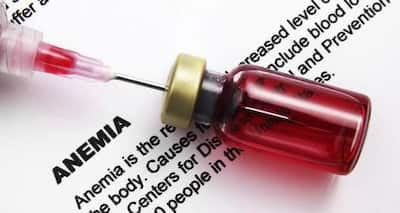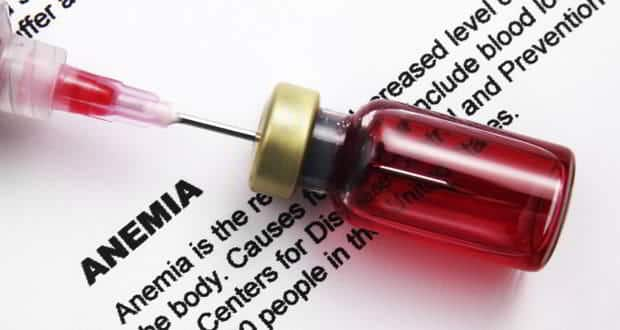Don’t Miss Out on the Latest Updates.
Subscribe to Our Newsletter Today!
Anemia - causes, symptoms, diagnosis and treatment

 In India 80% children and 70% pregnant women are afflicted with anemia. Red blood cell (RBCs or erythrocytes) is a type of blood cell which contains hemoglobin, an iron-containing protein, which is responsible for oxygen transportation around the body. In anemia there are fewer red blood cells or haemoglobin than normal. This causes a reduction in amount of oxygen carrying capacity in the bloodstream.
In India 80% children and 70% pregnant women are afflicted with anemia. Red blood cell (RBCs or erythrocytes) is a type of blood cell which contains hemoglobin, an iron-containing protein, which is responsible for oxygen transportation around the body. In anemia there are fewer red blood cells or haemoglobin than normal. This causes a reduction in amount of oxygen carrying capacity in the bloodstream.
Causes and Types
anemia can be caused by chronic blood loss due to gastritis, ulcers, piles, bowel cancer, prolonged use of painkillers, etc. anemia due to blood loss is also common in women who have heavy menstrual bleeding or have had multiple pregnancies.
Also Read
anemia may also be caused by decreased or defective production of red blood cells by the body. This can happen due to certain vitamin and minerals deficiencies. The mineral iron is necessary to make haemoglobin of the red blood cell. When the body does not produce enough haemoglobin due to lack of iron in the body iron deficiency anemia occurs. Lack of iron could be due to poor diet, heavy menstruation, poor absorption due to surgical removal of part of the stomach or small intestine, Crohn's disease, etc. The metabolic demands during pregnancy or childhood growth spurts can also increase iron consumption and thereby deplete iron stores in the body.
Lack of vitamins like folic acid and vitamin B12 can cause anemia. Folic acid is essential for the production of new red blood cells in the body. Spinach, green beans, sprouts, chickpeas, brown rice, etc. are good sources of folic acid. A lack of folic acid in the diet is the most common cause of folic acid deficiency anemia. Folic acid is important for the growing foetus. Hence its demand increases during pregnancy causing the folic acid reserves to be used up. When the increased demand is not met there is a risk of developing folic acid deficiency anemia in a pregnant woman which in turn can affect the health of the baby. Conditions of the gut like coeliac disease, etc. may cause poor absorption of folic acid and lead to anemia. Some medications like metformin, methotrexate, sulfasalazine, phenytoin, etc. can interfere with utilization of folic acid and cause anemia.
Vitamin B12 deficiency can also cause anemia. This vitamin is needed to make new red blood cells in the body Milk, green leafy vegetables, meat, eggs andfish are good sources of vitamin B12. It's very rare to lack vitamin B12 if a normal balanced diet is consumed. Vitamin B12 combines with a protein called intrinsic factor in the stomachand isabsorbed along with it in the small intestine. Pernicious anemia is an autoimmune disease in which the body is unable to absorb vitamin B12 because antibodies are formed against the intrinsic factor. Certain stomach or gut conditions like atrophic gastritis, surgical removal of stomach or small intestine, Crohn's disease, etc. may make it difficult to absorb adequate vitamin B12 and cause anemia. Prolonged use of drugs like metformin (diabetes medication), antacids, etc. may also interfere with absorption of dietary vitamin B12.
In sickle cell anemia a genetic defect causes the red blood cells to become sickle or crescent-shaped. The RBCs are fragile and break down rapidly and die prematurely, thereby causing anemia and depleting the body cells of adequate oxygen.
Thalassemia is an inherited blood disorder in which a defect in a gene causes the body to produce abnormal haemoglobin leading to anemia.
Blood cells develop from stem cells found in bone marrow. Diseases of the bone marrow like leukaemia, myelodysplasia, etc. can affect blood production and cause anemia. In aplastic anemia there is marked reduction or absence of stem cells due to infections, autoimmune diseases or drugs. This decreases the production of red blood cells causing anemia. Health conditions like cancer, advanced kidney disease, diabetes, hypothyroidism, etc. can decrease hormones needed for production of red blood cell and cause anemia.
When there is premature and excessive destruction of red blood cells such that the bone marrow is unable to replace them it is called haemolytic anemia.Such type of anemiamay either be inherited or may be developed later in life. It may be due to certain infections, toxins, blood disorders, drugs, etc.
Symptoms of anemia
Since there are many causes and types of anemia, its symptoms also vary accordingly.
Reduced amount of oxygen to the body tissues can cause some common symptoms like exhaustion, laziness, dizziness, breathlessness, paleness, muscle cramps, palpitations, etc.
Pica (craving for substances such as sand, ice, etc.), koilonychias (thin spoon-shaped fingernails), mouth sores, cracks or fissures at the corners of the mouth and smooth red painful tongue may be seen in iron deficiency anemia.
Folic acid deficiency anemia may cause loss of appetite and weight loss. There may be weakness, sore tongue, irritability, behavioural disorders, slow growth, inability to concentrate, etc. Longstanding vitamin B12 deficiency anemia can cause nerve problems like confusion, dementia, hallucinations, loss of touch sense, numbness, tingling sensation in the hands or feet, etc.
Delayed growth and development in children, susceptibility to infection, joint pain, etc. may be seen in sickle cell anemia.
Iron overload in thalassemia can damage the heart, liver and endocrine system. Thalassemia can cause slow growth in children, bone deformity and also increase the risk of infection.
Haemolytic anemia can cause yellow skin and eyes (jaundice), bruises under the skin, red urine, abdominal pain, fatigue, fainting, shortness of breath, chest pain and fluid accumulation in the skin of the legs (oedema) and in the abdominal cavity (ascites). Haemolytic anemia at birth can cause low rate of increase in the weight of the child.
Diagnosing anemia
A complete blood count can give information about the cells in your blood and confirm whether you are anaemic. It counts the number of red blood cells and measures the amount of haemoglobin in your blood. Additional tests may be done to determine the underlying cause of anemia. Pernicious anemia can be diagnosed by detecting the antibodies to intrinsic factor in the blood. A blood test may also be done to see blood iron level, serum ferritin level, levels of vitamin B-12 and folic acid, etc. The blood and urine may be tested for breakdown products of red blood cells for suspected haemolytic anemia. Rarely, a sample of bone marrow may be removed and studied to diagnose the cause of anemia. To know more, read 6 tests to check if you are anaemic.
Treatment for anemia
The choice of treatment for anemia depends on what's causing it.
Changes in the diet and iron supplements are all that's needed to treat iron deficiency anemia.
If the anemia is due to loss of blood the bleeding source must be traced and attended to.
A good diet and a tablet of folic acid a day is the treatment for folic acid deficiency anemia. During pregnancy folic acid tablets may be prescribed even if you are healthy.
Vitamin B12 oral tablets or injections may be prescribed for vitamin B12 deficiency anemia. These tablets or injections need to be taken for life if you have pernicious anemia. You will also need to increase the amount of vitamin B12 in your diet.
To treat underlying causes of other types of anemia specific treatment may be recommended. Children born with sickle-cell disease may need to take folic acid daily for life. Since they are prone to early childhood diseases they may also be prescribed antibiotics during the early years. Painkillers, blood transfusion and bone marrow transplant may be recommended for sickle cell anemia.
Thalassemia is a lifetime condition. Some forms of thalassemia may need to be managed lifelong with regular blood transfusions.
Treatment for aplastic anemia may include blood transfusions or a bone marrow transplant. Suppressing the immune system with steroids or immune suppressant drugs, treating infections, transfusing blood, splenectomy (removal of spleen) etc. are some of the treatments required to manage hemolytic anemia.
If a drug is causing the anemia the suspect medication needs to be avoided.
Most common types of anemia can be prevented by choosing a diet rich in variety of vitamins and nutrients. Few dietary changes can help you to keep your haemoglobin levels healthy naturally. Read more about 7 home remedies to keep anemia at bay and tips to increase haemoglobin levels naturally.
Read more about causes, symptoms, diagnosis and treatment of anemia.
For more articles on diseases & conditions , visit our diseases & conditions section. Follow us on Facebook and Twitter for all the latest updates! For daily free health tips, sign up for our newsletter. And to join discussions on health topics of your choice, visit our forum.


